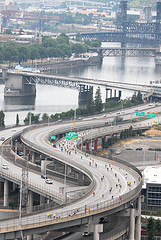As Portland and many other cities ponder big plans for bikeways in the coming years, one question that comes up a lot is how to pay for new infrastructure. When I’m asked that question, I say we don’t need to spend all our money on new bikeways because we’ve got all the infrastructure we need. What we need is the political will to re-allocate our existing road and highway network to accomodate bicycle traffic.
As we’ve experienced with the North Portland Greenway and the Sullivan’s Gulch trail projects, the development of off-street bikeways takes many years and millions of dollars to complete (one piece of the Sullivan’s Gulch from the Esplanade to NE 21st is estimated to cost $7.7 million).
So, why not use the infrastructure we already have? It just so happens there’s an interstate a few feet from the proposed Sullivan’s Gulch trail alignment and, downtown Portland is hemmed in all sides by highways.
And in turns out that I’m not the only one thinking like this.
In an article titled Rethinking the Interstate published in Metropolis Magazine in January 2009, Congressman Earl Blumenauer said our nation’s expansive highway network represents “a tremendous national untapped resource.”
Here’s more:
“What if we could make those highways beautiful… by using the corridors for more than moving cars and trucks? What if we thought of them as the backbone of a new, more diverse 21st-century transportation system? ‘It’s time for a different vision,’ Blumenauer says. ‘And a principle for that is how we coax more out of existing resources.'”
That article didn’t specifically mention bicycles (it focused on rail and hubs for electric cars), but as more and more people go by bike, why not use the many acres of urban interstates to move human-powered vehicles?
In Portland, our Highway 26 provides the most direct and flat route up and over our West Hills. Some commuters (and Zoobombers on occasion) already use it in the downhill direction, and a more pleasant lane of their own would coax some of them to commute up it as well. There’s also the Fremont Bridge. For North Portland residents, that bridge could be a direct link to Northwest Portland. And how about I-84? Instead of working for years on a trail project that might never happen, why not simply build a bikeway onto the existing highway?
And this same thinking doesn’t need to stop at highways. Think of streets like Sandy, MLK, Grand, and so on, where the space exists for bicycles, but where currently only the “strong and fearless” dare tread.
The idea of “bicycle highways” got some major exposure in the latest New York Times Magazine. They focus more on plans for bicycle-only highways in Copenhagen, but shared highways might be a more practical first step.
On that note, another initiative that’s gaining steam in America is Adventure Cycling’s U.S. Bicycle Route System. That effort identifies existing transportation corridors that, once identified and connected, would result in a nationwide bikeway network similar in concept to interstate highway system (we’ll host a live interview and Q&A with an Adventure Cycling staffer on that project in February. Stay tuned for details).
The City of Portland has already done some re-allocating — the new cycle track on Broadway and buffered bike lanes on SW Stark and Oak are good examples. Those projects were done at a very affordable cost and they provide a much more comfortable and feasible space for bike traffic than the standard bike lanes of yore. So now, perhaps we just need to to expand on that example and have bicycles boldly go where no bicycles have gone before.


